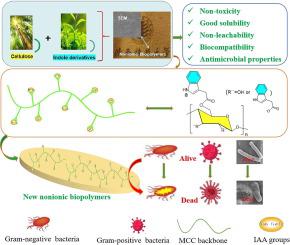Chemical Engineering Journal ( IF 15.1 ) Pub Date : 2023-05-31 , DOI: 10.1016/j.cej.2023.143810 Xugang Dang , Zhenfu Yu , Xuechuan Wang , Yongmei Du , Caihong Wang

|
Novel soluble cellulose-based nonionic biopolymers (CIs) with enhanced antimicrobial properties and nonleachability were successfully produced using a sustainable one-pot synthesis method. Fourier transform infrared spectroscopy (FTIR), Nuclear magnetic resonance H-spectrometer (1H-NMR), X-ray Photoelectron Spectroscopy (XPS), and Energy Dispersive Spectroscopy (EDS) results demonstrated that the cellulose (MCC) molecules combined with indole-3-acetic acid (IAA) via esterification to produce CIs with abundant terminal indole groups. The degree of substitution of the prepared CI3 reached 1.85 when the molar ratio of IAA to MCC molecules was 4:1. The prepared CI samples were characterized using X-ray diffractometer (XRD), Scanning Electronic Microscopy (SEM), Thermogravimetric Analysis (TGA), and other analysis techniques. Results indicated that after the MCC was grafted with IAA, its crystallinity decreased and solubility increased. After blending CI3 with polycaprolactone (PCL) to form cellulose-based antimicrobial (PCL–CI) films, the films showed good compatibility, preferable biological cell activity, and low water vapor permeability. When the CI3 content was 10%, the tensile strength of the produced PCL–CI10 film reached 9.96 MPa. Moreover, the prepared PCL–CI films exhibited good nonleachability after being immersed in water for 5 d. The disk diffusion assay revealed that the CIs and PCL–CI films had good antimicrobial and bactericidal effects against Gram-positive bacteria (Staphylococcus aureus) and Gram-negative bacteria (Escherichia coli). The minimal inhibitory concentration was 5 μg disk−1, significantly lower than that of traditional antibiotics and chitosan. The nonionic biopolymers are simple and efficient to prepare and ecofriendly as well as exhibit nontoxicity, good solubility, enhanced antimicrobial properties, and nonleachability, which can provide new ideas for developing natural biomass-based nonionic antimicrobial materials with potential applications in wound dressing, medical devices, and food packaging.
中文翻译:

用于天然抗菌材料的新型可溶性纤维素基非离子生物聚合物的可持续一锅法合成
新型可溶性纤维素基非离子生物聚合物 (CI) 具有增强的抗菌性能和不可浸出性,使用可持续的一锅法合成方法成功生产。傅立叶变换红外光谱 (FTIR)、核磁共振氢谱仪 ( 1H-NMR)、X 射线光电子能谱 (XPS) 和能谱 (EDS) 结果表明,纤维素 (MCC) 分子与吲哚-3-乙酸 (IAA) 通过酯化反应生成具有丰富末端吲哚的 CIs团体。当IAA与MCC分子的摩尔比为4:1时,制备的Cl3的取代度达到1.85。使用 X 射线衍射仪 (XRD)、扫描电子显微镜 (SEM)、热重分析 (TGA) 和其他分析技术对制备的 CI 样品进行表征。结果表明,MCC接枝IAA后,其结晶度降低,溶解度增加。CI3与聚己内酯(PCL)共混形成纤维素基抗菌(PCL-CI)薄膜后,薄膜表现出良好的相容性、较好的生物细胞活性,和低水蒸气渗透性。当Cl3含量为10%时,所制备的PCL-CI10薄膜的拉伸强度达到9.96 MPa。此外,制备的 PCL-CI 薄膜在水中浸泡 5 天后表现出良好的非浸出性。纸片扩散试验表明,CIs 和 PCL-CI 膜对革兰氏阳性菌具有良好的抗菌和杀菌作用(金黄色葡萄球菌)和革兰氏阴性菌(大肠杆菌)。最低抑菌浓度为5μg disk -1,明显低于传统抗生素和壳聚糖。非离子生物聚合物制备简单高效,环境友好,无毒,溶解性好,抗菌性能增强,不可浸出,可为开发天然生物质基非离子抗菌材料提供新思路,在伤口敷料、医疗器械等领域具有潜在应用和食品包装。



























 京公网安备 11010802027423号
京公网安备 11010802027423号